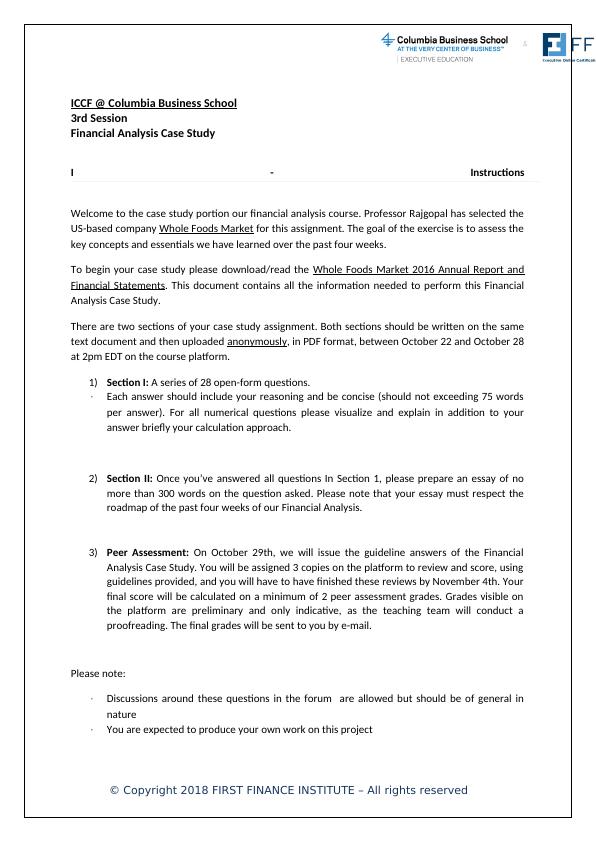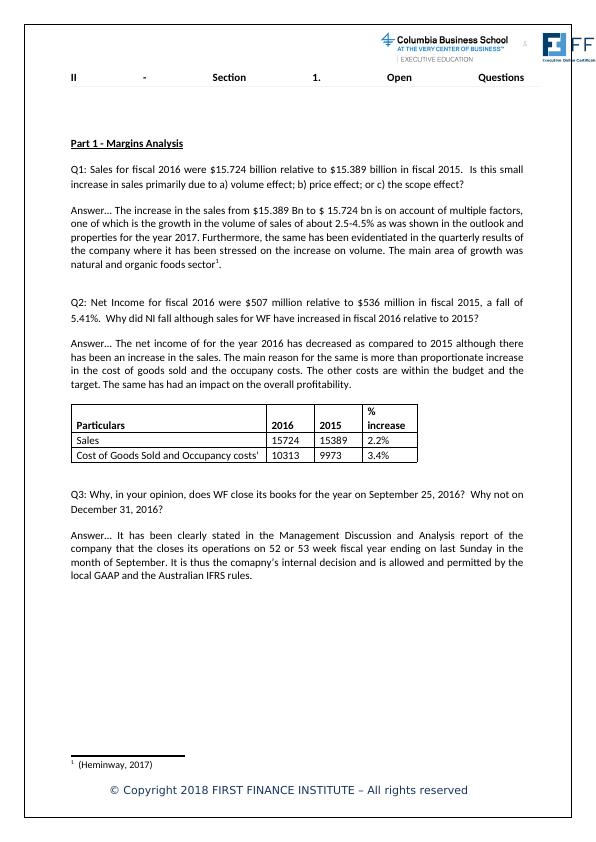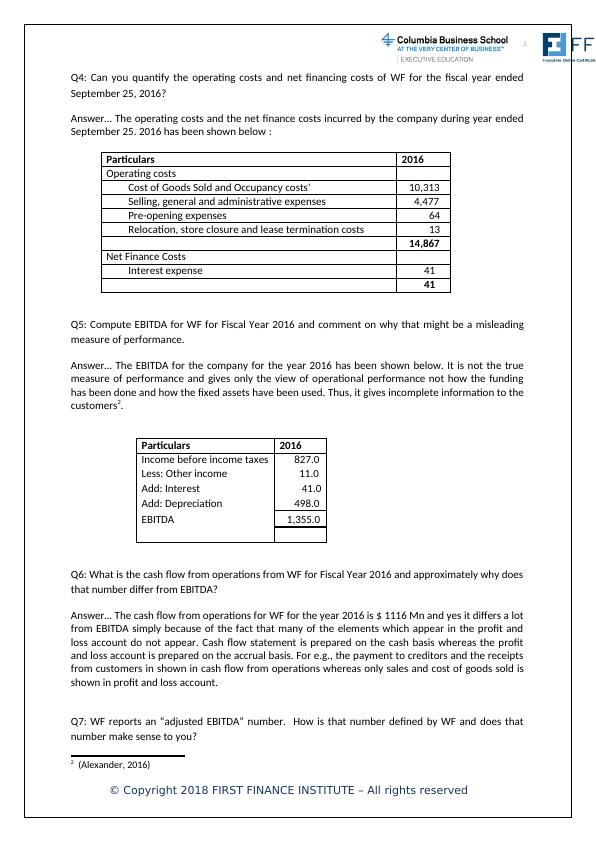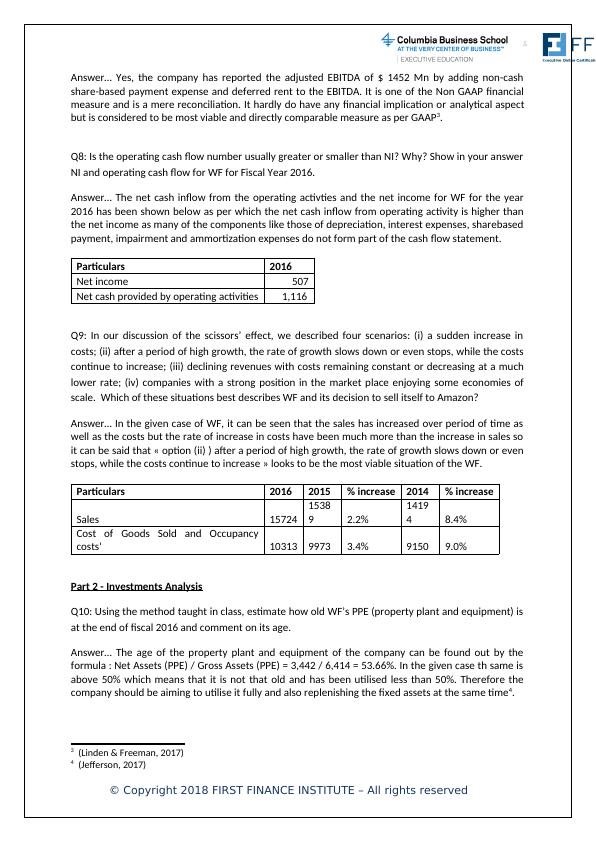Financial Analysis Case Study of Whole Foods Market for ICCF @ Columbia Business School
Perform a financial analysis of Whole Foods Market based on their 2016 Annual Report and Financial Statements.
11 Pages4467 Words470 Views
Added on 2023-06-03
About This Document
This case study is a part of the financial analysis course at ICCF @ Columbia Business School. It focuses on the analysis of Whole Foods Market's 2016 Annual Report and Financial Statements. The case study includes 28 open-form questions and an essay of no more than 300 words. It covers topics such as margins analysis, investments analysis, and financing analysis.
Financial Analysis Case Study of Whole Foods Market for ICCF @ Columbia Business School
Perform a financial analysis of Whole Foods Market based on their 2016 Annual Report and Financial Statements.
Added on 2023-06-03
ShareRelated Documents
ICCF @ Columbia Business School
3rd Session
Financial Analysis Case Study
I - Instructions
Welcome to the case study portion our financial analysis course. Professor Rajgopal has selected the
US-based company Whole Foods Market for this assignment. The goal of the exercise is to assess the
key concepts and essentials we have learned over the past four weeks.
To begin your case study please download/read the Whole Foods Market 2016 Annual Report and
Financial Statements. This document contains all the information needed to perform this Financial
Analysis Case Study.
There are two sections of your case study assignment. Both sections should be written on the same
text document and then uploaded anonymously, in PDF format, between October 22 and October 28
at 2pm EDT on the course platform.
1) Section I: A series of 28 open-form questions.
Each answer should include your reasoning and be concise (should not exceeding 75 words
per answer). For all numerical questions please visualize and explain in addition to your
answer briefly your calculation approach.
2) Section II: Once you’ve answered all questions In Section 1, please prepare an essay of no
more than 300 words on the question asked. Please note that your essay must respect the
roadmap of the past four weeks of our Financial Analysis.
3) Peer Assessment: On October 29th, we will issue the guideline answers of the Financial
Analysis Case Study. You will be assigned 3 copies on the platform to review and score, using
guidelines provided, and you will have to have finished these reviews by November 4th. Your
final score will be calculated on a minimum of 2 peer assessment grades. Grades visible on
the platform are preliminary and only indicative, as the teaching team will conduct a
proofreading. The final grades will be sent to you by e-mail.
Please note:
Discussions around these questions in the forum are allowed but should be of general in
nature
You are expected to produce your own work on this project
© Copyright 2018 FIRST FINANCE INSTITUTE – All rights reserved
3rd Session
Financial Analysis Case Study
I - Instructions
Welcome to the case study portion our financial analysis course. Professor Rajgopal has selected the
US-based company Whole Foods Market for this assignment. The goal of the exercise is to assess the
key concepts and essentials we have learned over the past four weeks.
To begin your case study please download/read the Whole Foods Market 2016 Annual Report and
Financial Statements. This document contains all the information needed to perform this Financial
Analysis Case Study.
There are two sections of your case study assignment. Both sections should be written on the same
text document and then uploaded anonymously, in PDF format, between October 22 and October 28
at 2pm EDT on the course platform.
1) Section I: A series of 28 open-form questions.
Each answer should include your reasoning and be concise (should not exceeding 75 words
per answer). For all numerical questions please visualize and explain in addition to your
answer briefly your calculation approach.
2) Section II: Once you’ve answered all questions In Section 1, please prepare an essay of no
more than 300 words on the question asked. Please note that your essay must respect the
roadmap of the past four weeks of our Financial Analysis.
3) Peer Assessment: On October 29th, we will issue the guideline answers of the Financial
Analysis Case Study. You will be assigned 3 copies on the platform to review and score, using
guidelines provided, and you will have to have finished these reviews by November 4th. Your
final score will be calculated on a minimum of 2 peer assessment grades. Grades visible on
the platform are preliminary and only indicative, as the teaching team will conduct a
proofreading. The final grades will be sent to you by e-mail.
Please note:
Discussions around these questions in the forum are allowed but should be of general in
nature
You are expected to produce your own work on this project
© Copyright 2018 FIRST FINANCE INSTITUTE – All rights reserved

II - Section 1. Open Questions
Part 1 - Margins Analysis
Q1: Sales for fiscal 2016 were $15.724 billion relative to $15.389 billion in fiscal 2015. Is this small
increase in sales primarily due to a) volume effect; b) price effect; or c) the scope effect?
Answer... The increase in the sales from $15.389 Bn to $ 15.724 bn is on account of multiple factors,
one of which is the growth in the volume of sales of about 2.5-4.5% as was shown in the outlook and
properties for the year 2017. Furthermore, the same has been evidentiated in the quarterly results of
the company where it has been stressed on the increase on volume. The main area of growth was
natural and organic foods sector1.
Q2: Net Income for fiscal 2016 were $507 million relative to $536 million in fiscal 2015, a fall of
5.41%. Why did NI fall although sales for WF have increased in fiscal 2016 relative to 2015?
Answer... The net income of for the year 2016 has decreased as compared to 2015 although there
has been an increase in the sales. The main reason for the same is more than proportionate increase
in the cost of goods sold and the occupany costs. The other costs are within the budget and the
target. The same has had an impact on the overall profitability.
Particulars 2016 2015
%
increase
Sales 15724 15389 2.2%
Cost of Goods Sold and Occupancy costs' 10313 9973 3.4%
Q3: Why, in your opinion, does WF close its books for the year on September 25, 2016? Why not on
December 31, 2016?
Answer... It has been clearly stated in the Management Discussion and Analysis report of the
company that the closes its operations on 52 or 53 week fiscal year ending on last Sunday in the
month of September. It is thus the comapny’s internal decision and is allowed and permitted by the
local GAAP and the Australian IFRS rules.
1 (Heminway, 2017)
© Copyright 2018 FIRST FINANCE INSTITUTE – All rights reserved
Part 1 - Margins Analysis
Q1: Sales for fiscal 2016 were $15.724 billion relative to $15.389 billion in fiscal 2015. Is this small
increase in sales primarily due to a) volume effect; b) price effect; or c) the scope effect?
Answer... The increase in the sales from $15.389 Bn to $ 15.724 bn is on account of multiple factors,
one of which is the growth in the volume of sales of about 2.5-4.5% as was shown in the outlook and
properties for the year 2017. Furthermore, the same has been evidentiated in the quarterly results of
the company where it has been stressed on the increase on volume. The main area of growth was
natural and organic foods sector1.
Q2: Net Income for fiscal 2016 were $507 million relative to $536 million in fiscal 2015, a fall of
5.41%. Why did NI fall although sales for WF have increased in fiscal 2016 relative to 2015?
Answer... The net income of for the year 2016 has decreased as compared to 2015 although there
has been an increase in the sales. The main reason for the same is more than proportionate increase
in the cost of goods sold and the occupany costs. The other costs are within the budget and the
target. The same has had an impact on the overall profitability.
Particulars 2016 2015
%
increase
Sales 15724 15389 2.2%
Cost of Goods Sold and Occupancy costs' 10313 9973 3.4%
Q3: Why, in your opinion, does WF close its books for the year on September 25, 2016? Why not on
December 31, 2016?
Answer... It has been clearly stated in the Management Discussion and Analysis report of the
company that the closes its operations on 52 or 53 week fiscal year ending on last Sunday in the
month of September. It is thus the comapny’s internal decision and is allowed and permitted by the
local GAAP and the Australian IFRS rules.
1 (Heminway, 2017)
© Copyright 2018 FIRST FINANCE INSTITUTE – All rights reserved

Q4: Can you quantify the operating costs and net financing costs of WF for the fiscal year ended
September 25, 2016?
Answer... The operating costs and the net finance costs incurred by the company during year ended
September 25. 2016 has been shown below :
Particulars 2016
Operating costs
Cost of Goods Sold and Occupancy costs' 10,313
Selling, general and administrative expenses 4,477
Pre-opening expenses 64
Relocation, store closure and lease termination costs 13
14,867
Net Finance Costs
Interest expense 41
41
Q5: Compute EBITDA for WF for Fiscal Year 2016 and comment on why that might be a misleading
measure of performance.
Answer... The EBITDA for the company for the year 2016 has been shown below. It is not the true
measure of performance and gives only the view of operational performance not how the funding
has been done and how the fixed assets have been used. Thus, it gives incomplete information to the
customers2.
Particulars 2016
Income before income taxes
Less: Other income
827.0
11.0
Add: Interest 41.0
Add: Depreciation 498.0
EBITDA 1,355.0
Q6: What is the cash flow from operations from WF for Fiscal Year 2016 and approximately why does
that number differ from EBITDA?
Answer... The cash flow from operations for WF for the year 2016 is $ 1116 Mn and yes it differs a lot
from EBITDA simply because of the fact that many of the elements which appear in the profit and
loss account do not appear. Cash flow statement is prepared on the cash basis whereas the profit
and loss account is prepared on the accrual basis. For e.g., the payment to creditors and the receipts
from customers in shown in cash flow from operations whereas only sales and cost of goods sold is
shown in profit and loss account.
Q7: WF reports an “adjusted EBITDA” number. How is that number defined by WF and does that
number make sense to you?
2 (Alexander, 2016)
© Copyright 2018 FIRST FINANCE INSTITUTE – All rights reserved
September 25, 2016?
Answer... The operating costs and the net finance costs incurred by the company during year ended
September 25. 2016 has been shown below :
Particulars 2016
Operating costs
Cost of Goods Sold and Occupancy costs' 10,313
Selling, general and administrative expenses 4,477
Pre-opening expenses 64
Relocation, store closure and lease termination costs 13
14,867
Net Finance Costs
Interest expense 41
41
Q5: Compute EBITDA for WF for Fiscal Year 2016 and comment on why that might be a misleading
measure of performance.
Answer... The EBITDA for the company for the year 2016 has been shown below. It is not the true
measure of performance and gives only the view of operational performance not how the funding
has been done and how the fixed assets have been used. Thus, it gives incomplete information to the
customers2.
Particulars 2016
Income before income taxes
Less: Other income
827.0
11.0
Add: Interest 41.0
Add: Depreciation 498.0
EBITDA 1,355.0
Q6: What is the cash flow from operations from WF for Fiscal Year 2016 and approximately why does
that number differ from EBITDA?
Answer... The cash flow from operations for WF for the year 2016 is $ 1116 Mn and yes it differs a lot
from EBITDA simply because of the fact that many of the elements which appear in the profit and
loss account do not appear. Cash flow statement is prepared on the cash basis whereas the profit
and loss account is prepared on the accrual basis. For e.g., the payment to creditors and the receipts
from customers in shown in cash flow from operations whereas only sales and cost of goods sold is
shown in profit and loss account.
Q7: WF reports an “adjusted EBITDA” number. How is that number defined by WF and does that
number make sense to you?
2 (Alexander, 2016)
© Copyright 2018 FIRST FINANCE INSTITUTE – All rights reserved

Answer... Yes, the company has reported the adjusted EBITDA of $ 1452 Mn by adding non-cash
share-based payment expense and deferred rent to the EBITDA. It is one of the Non GAAP financial
measure and is a mere reconciliation. It hardly do have any financial implication or analytical aspect
but is considered to be most viable and directly comparable measure as per GAAP3.
Q8: Is the operating cash flow number usually greater or smaller than NI? Why? Show in your answer
NI and operating cash flow for WF for Fiscal Year 2016.
Answer... The net cash inflow from the operating activties and the net income for WF for the year
2016 has been shown below as per which the net cash inflow from operating activity is higher than
the net income as many of the components like those of depreciation, interest expenses, sharebased
payment, impairment and ammortization expenses do not form part of the cash flow statement.
Particulars 2016
Net income 507
Net cash provided by operating activities 1,116
Q9: In our discussion of the scissors’ effect, we described four scenarios: (i) a sudden increase in
costs; (ii) after a period of high growth, the rate of growth slows down or even stops, while the costs
continue to increase; (iii) declining revenues with costs remaining constant or decreasing at a much
lower rate; (iv) companies with a strong position in the market place enjoying some economies of
scale. Which of these situations best describes WF and its decision to sell itself to Amazon?
Answer... In the given case of WF, it can be seen that the sales has increased over period of time as
well as the costs but the rate of increase in costs have been much more than the increase in sales so
it can be said that « option (ii) ) after a period of high growth, the rate of growth slows down or even
stops, while the costs continue to increase » looks to be the most viable situation of the WF.
Particulars 2016 2015 % increase 2014 % increase
Sales 15724
1538
9 2.2%
1419
4 8.4%
Cost of Goods Sold and Occupancy
costs' 10313 9973 3.4% 9150 9.0%
Part 2 - Investments Analysis
Q10: Using the method taught in class, estimate how old WF’s PPE (property plant and equipment) is
at the end of fiscal 2016 and comment on its age.
Answer... The age of the property plant and equipment of the company can be found out by the
formula : Net Assets (PPE) / Gross Assets (PPE) = 3,442 / 6,414 = 53.66%. In the given case th same is
above 50% which means that it is not that old and has been utilised less than 50%. Therefore the
company should be aiming to utilise it fully and also replenishing the fixed assets at the same time4.
3 (Linden & Freeman, 2017)
4 (Jefferson, 2017)
© Copyright 2018 FIRST FINANCE INSTITUTE – All rights reserved
share-based payment expense and deferred rent to the EBITDA. It is one of the Non GAAP financial
measure and is a mere reconciliation. It hardly do have any financial implication or analytical aspect
but is considered to be most viable and directly comparable measure as per GAAP3.
Q8: Is the operating cash flow number usually greater or smaller than NI? Why? Show in your answer
NI and operating cash flow for WF for Fiscal Year 2016.
Answer... The net cash inflow from the operating activties and the net income for WF for the year
2016 has been shown below as per which the net cash inflow from operating activity is higher than
the net income as many of the components like those of depreciation, interest expenses, sharebased
payment, impairment and ammortization expenses do not form part of the cash flow statement.
Particulars 2016
Net income 507
Net cash provided by operating activities 1,116
Q9: In our discussion of the scissors’ effect, we described four scenarios: (i) a sudden increase in
costs; (ii) after a period of high growth, the rate of growth slows down or even stops, while the costs
continue to increase; (iii) declining revenues with costs remaining constant or decreasing at a much
lower rate; (iv) companies with a strong position in the market place enjoying some economies of
scale. Which of these situations best describes WF and its decision to sell itself to Amazon?
Answer... In the given case of WF, it can be seen that the sales has increased over period of time as
well as the costs but the rate of increase in costs have been much more than the increase in sales so
it can be said that « option (ii) ) after a period of high growth, the rate of growth slows down or even
stops, while the costs continue to increase » looks to be the most viable situation of the WF.
Particulars 2016 2015 % increase 2014 % increase
Sales 15724
1538
9 2.2%
1419
4 8.4%
Cost of Goods Sold and Occupancy
costs' 10313 9973 3.4% 9150 9.0%
Part 2 - Investments Analysis
Q10: Using the method taught in class, estimate how old WF’s PPE (property plant and equipment) is
at the end of fiscal 2016 and comment on its age.
Answer... The age of the property plant and equipment of the company can be found out by the
formula : Net Assets (PPE) / Gross Assets (PPE) = 3,442 / 6,414 = 53.66%. In the given case th same is
above 50% which means that it is not that old and has been utilised less than 50%. Therefore the
company should be aiming to utilise it fully and also replenishing the fixed assets at the same time4.
3 (Linden & Freeman, 2017)
4 (Jefferson, 2017)
© Copyright 2018 FIRST FINANCE INSTITUTE – All rights reserved

End of preview
Want to access all the pages? Upload your documents or become a member.
Related Documents
MGT524 Research Methods in Business: 2nd Article Annotation (Quantitative)lg...
|9
|2167
|255
Business Evaluation Report - Twanji Variety Storeslg...
|9
|2316
|40
Public Policy Exception Assignmentlg...
|4
|1515
|178
Economic and Legal Context for Financial Planning (FPC001B) Analysis Tasklg...
|10
|3344
|322
Introduction to Real-World Annual Reports | Case Study Assignmentlg...
|25
|8159
|20
Statistical Methods in Epidemiology (401176)lg...
|4
|1347
|268
